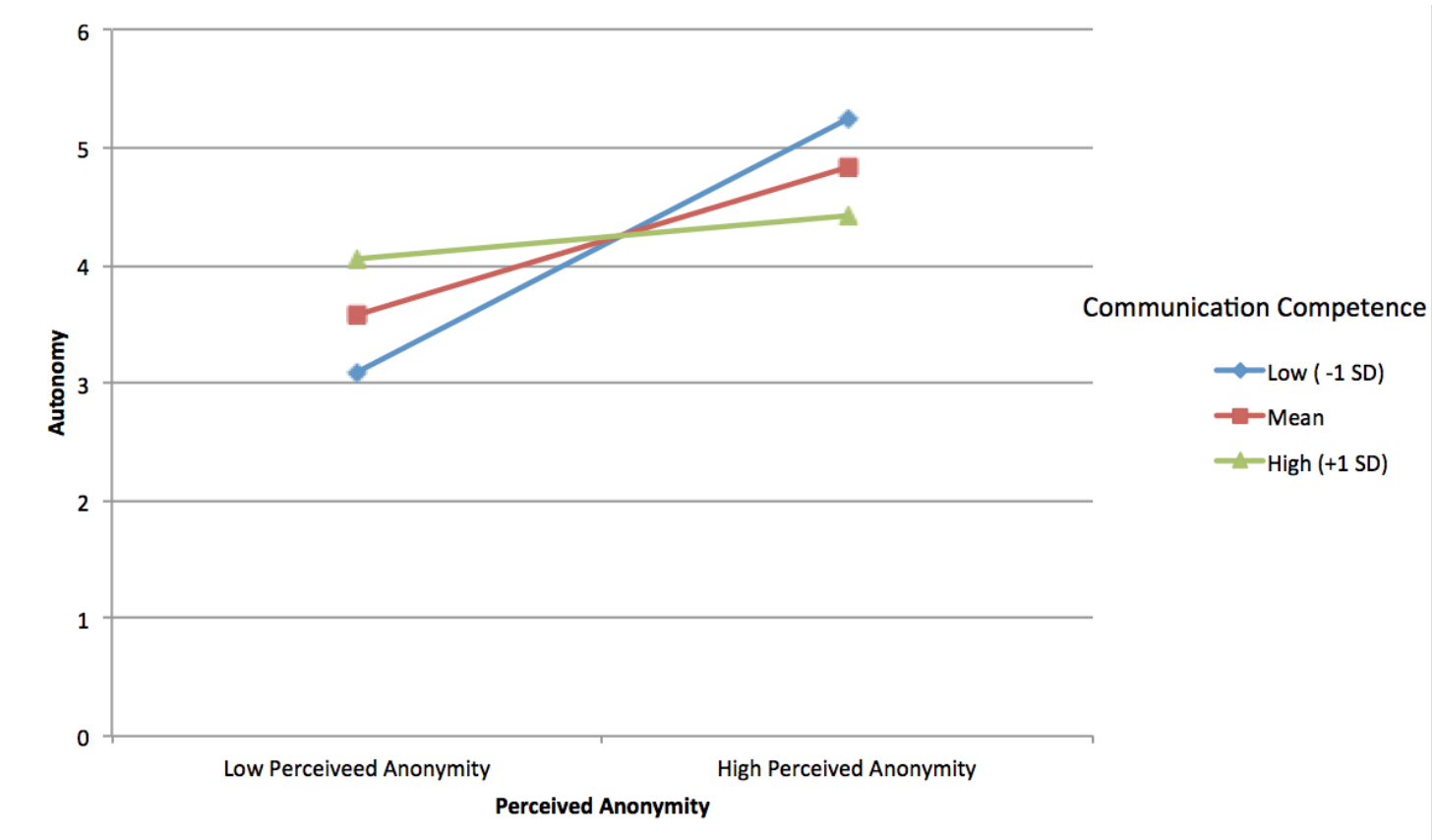Media Effects Research Lab - Research Archive
So you use Whisper? Exploring the Psychological Effects of Anonymous Social Networking Application
Student Researcher(s)
Ruoxu Wang (Ph.D Candidate);
Dong Chen (Ph.D Candidate);
Faculty Supervisor
Introduction
Anonymous social networking applications such as Whisper and YikYak are quite popular nowadays. An online survey (N = 147) explored the psychological effects of using Whisper. Results showed that people’s liking toward the anonymity affordance and their level of perceived anonymity affordance could positively predict recovery, catharsis and autonomy. In addition, people with low communication competence tend to feel a higher level of autonomy when they really like the anonymity feature of Whisper.
Research Questions
R1a: When using Whisper, how does a user’s liking toward anonymity affordance influence his/her level of recovery, catharsis and autonomy?
R1b: When using Whisper, how does a user’s perceived level of anonymity affordance influence his/her level of recovery, catharsis, and autonomy?
RQ2a - d: When using Whisper, does a user’s level of a) communication apprehension, b) communication competence, c) collective self esteem, and d) psychological empowerment moderate the effects of liking towards anonymity affordance and user’s level of recovery, catharsis, and autonomy?
RQ3a - d: When using Whisper, does a user’s level of a) communication apprehension, b) communication competence, c) collective self esteem, and d) psychological empowerment moderate the effects of perceived level of anonymity affordance and user’s level of recovery, catharsis, and autonomy?
Method
An online survey was conducted among 147 students recruited from an U.S. university. All participants gave their consent before they completed the 20-minute survey and were awarded with extra credits for their participation.
Results
RQ1 was raised to see if liking toward anonymity affordance would influence people’s level of recovery, catharsis, and autonomy when using Whisper. A simple linear regression was calculated to predict recovery based on liking toward anonymity affordance. A significant regression equation was found, F (1, 145) = 13.93, p < .001, with an R2 of .09. Participants’ recovery level equals to 2.48 + .32 (liking toward anonymity affordance) when liking toward anonymity affordance is measured in how much do you like the anonymity affordance in Whisper. Autonomy increased .32 when liking toward anonymity affordance increased.
A simple linear regression was calculated to predict catharsis based on liking toward anonymity affordance. A significant regression equation was found, F (1, 145) = 6.78, p < .05, with an R2 of .05. Participants’ level of catharsis is equal to 2.75 + .22 (liking toward anonymity affordance) when liking toward anonymity affordance is measured in how much do you like the anonymity affordance in Whisper. Catharsis increased .22 when liking toward anonymity affordance increased.
A simple linear regression was calculated to predict autonomy based on liking toward anonymity affordance. A significant regression equation was found, F (1, 145) = 5.46, p < .05, with an R2 of .04. Participants’ level of autonomy is equal to 3.25 + .22 (liking toward anonymity affordance) when liking toward anonymity affordance is measured in how much do you like the anonymity affordance in Whisper. Autonomy increased .22 when liking toward anonymity affordance increased.
RQ2 was raised to see if perceived level of anonymity affordance would influence their level of recovery, catharsis and autonomy when using Whisper. A simple linear regression was calculated to predict recovery based on level of perceived anonymity affordance. A significant regression equation was found, F (1, 145) = 21.49, p < .001, with an R2 of .13. Participants’ level of recovery is equal to 2.24 + .35 (perceived level of anonymity affordance) when perceived level of anonymity affordance is measured in how anonymous do you perceive the anonymity affordance in Whisper. Recovery increased .35 when perceived level of anonymity affordance increased.
A simple linear regression was calculated to predict catharsis based on level of perceived anonymity affordance. A significant regression equation was found, F (1, 145) = 21.49, p < .001, with an R2 of .13. Participants’ level of catharsis is equal to 2.65 + .23 (perceived level of anonymity affordance) when perceived level of anonymity affordance is measured in how anonymous do you perceive the anonymity affordance in Whisper. Catharsis increased .23 when perceived level of anonymity affordance increased.
A simple linear regression was calculated to predict autonomy based on level of perceived anonymity affordance. A significant regression equation was found, F (1, 145) = 10.35, p < .01, with an R2 of .07. Participants’ level of autonomy is equal to 2.95 + .27 (perceived level of anonymity affordance) when perceived level of anonymity affordance is measured in how anonymous do you perceive the anonymity affordance in Whisper. Autonomy increased .27 when perceived level of anonymity affordance increased.
To answer RQ2a-d and RQ3a-d, a series of hierarchical multiple regression analyses were conducted. Results showed that communication competence was a significant moderator between perceived level of anonymity affordance and autonomy, ΔR2 = .04, F (3, 143) = 5.49, p < .01. As shown in Figure 1, for people with low communication competence, the more they perceive the level of anonymity affordance of Whisper, the more autonomy they will receive when using Whisper. For people with low or average level of communication competence, how they perceive the level of anonymity affordance of Whisper does not really impact their feeling of autonomy.

Conclusion
The popularity of anonymous social networking applications triggered our interests in examining people’s psychological needs in using these new social network sites. The current study revealed people’s psychological needs pertaining to recovery, catharsis, and autonomy were the psychological outcomes of using anonymous social networking application. These psychological outcomes were significantly linked with people’s liking toward anonymity affordance and their level of perceived anonymity affordance. Psychological traits such as communication competence could moderate the effects of one’s level of perceived anonymity affordance and autonomy.
For more details regarding the study contact
Dr. S. Shyam Sundar by e-mail at sss12@psu.edu or by telephone at (814) 865-2173

